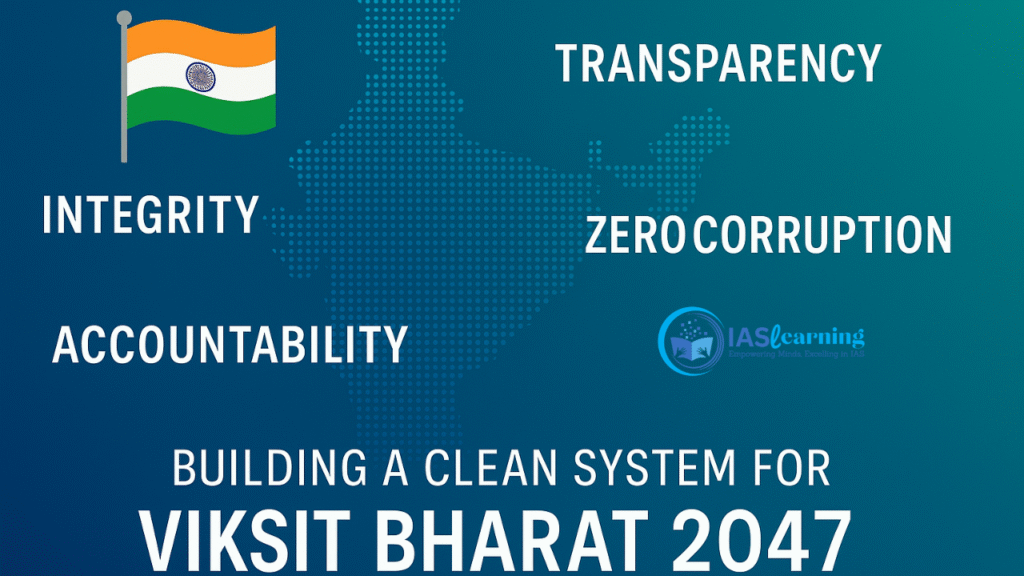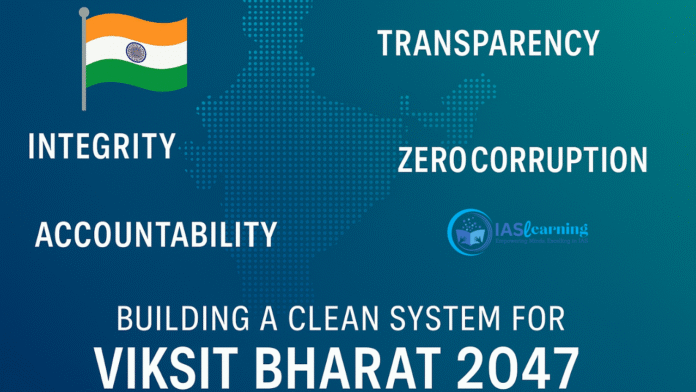Syllabus: GS Paper 2 – Governance, Transparency, and Accountability
Context
As India moves toward its vision of Viksit Bharat (Developed Nation) by 2047, a clean, transparent, and accountable governance system is essential.
Corruption is not only an ethical issue — it is an economic burden that reduces productivity, weakens institutions, and deepens inequality. A nation cannot become Viksit Bharat if corruption continues to drain public resources and erode trust in institutions.
Understanding Corruption in India

The Santhanam Committee Report (1964) defined corruption as behavior by public officials that illegally enriches themselves or others through misuse of position.
The Central Vigilance Commission (CVC) expressed it simply:
Corruption = Discretion + Mystification – Accountability
When discretion is unchecked, decisions are hidden, and officials face no accountability — corruption thrives.
To achieve the dream of Viksit Bharat, India must reverse this equation through transparency, digitization, and institutional integrity.
Current Landscape: How Deep is the Problem?
1. Economic Cost of Corruption
- Studies show that a 1% rise in corruption can reduce GDP per capita by 1.5%.
- Corruption leads to poor-quality public infrastructure, inefficient subsidies, and weakened investor confidence.
- It diverts funds away from education, health, and innovation — the very sectors that drive Viksit Bharat’s growth.
2. Judicial Delays and Enforcement Gaps
- Over 7,000 corruption cases investigated by the CBI are still pending trial.
- 379 cases have been stuck in courts for over 20 years.
- The Lokpal, India’s anti-corruption ombudsman, has acted in only 24 cases over five years.
Without judicial reform, even the strongest laws will remain toothless.
3. India’s Global Corruption Rankings
- Transparency International (2024): India ranked 96th of 180 nations with a score of 38/100.
- World Bank (2023): Control of Corruption Index places India 108th of 193 nations.
Despite progress in e-governance and digital tools, India’s corruption perception remains stagnant — a red flag for its Viksit Bharat ambitions.
Institutional Framework: India’s Anti-Corruption Architecture
Ethics in Governance – 2nd ARC Report
The Second Administrative Reforms Commission (ARC) emphasized that ethical governance is the foundation of effective administration. It laid out four guiding principles:
- Integrity – Acting with honesty and moral purpose.
- Accountability – Owning up to decisions and outcomes.
- Transparency – Making processes open to public view.
- Fairness – Ensuring justice and equality in every decision.
A truly Viksit Bharat demands that these principles guide every public servant.
Central Civil Services (Conduct) Rules, 1964
These rules set the ethical standards for government officials:
- Maintain absolute integrity.
- Avoid conflicts of interest.
- Uphold constitutional values.
Such standards must evolve alongside India’s modernization, integrating ethics with technology-driven governance.
Prevention of Corruption Act, 1988 (Amended 2018)
The Prevention of Corruption Act (PCA) is India’s primary anti-graft legislation.
Its 2018 amendment introduced:
- Corporate liability for bribery.
- Prior sanction before prosecuting public officials.
- Stronger protection for whistleblowers.
While designed to protect honest officials, prior sanction requirements often delay accountability — a challenge India must address for a Viksit Bharat future.
Central Vigilance Commission (CVC) and Lokpal
The CVC (2003) oversees vigilance in ministries and PSUs, while the Lokpal (2013) acts as an independent anti-corruption body.
However, delays in appointments and limited powers have restricted their impact.
Empowering these institutions with autonomy and technology is essential for a corruption-free Viksit Bharat.
E-Governance and the Zero-Tolerance Approach
India’s fight against corruption has made progress through digital governance reforms, such as:
- Direct Benefit Transfer (DBT): Minimizes middlemen and leakages.
- Government e-Marketplace (GeM): Promotes transparent procurement.
- E-Tendering and Paperless Offices: Reduce discretion in public dealings.
- Removal of Interviews for Lower Posts: Reduces nepotism and bribery.
These steps reflect the government’s commitment to a zero-tolerance policy against corruption — a vital building block for Viksit Bharat.
Strategies for Reducing Corruption
1. Simplify the Regulatory Framework
A maze of complex laws across taxation, trade, and land acquisition breeds discretion. Simplifying and digitizing these processes reduces human interaction — the root cause of corruption.
Digital India initiatives must evolve into Smart Governance Systems, where rules are clear, processes are automatic, and approvals are time-bound.
2. Enhance Bureaucratic Accountability
Introduce mandatory 10-year asset audits for senior officials.
AI-based monitoring can detect unexplained wealth, triggering automatic investigations.
Accountability should not depend on complaints — it should be a systemic function of good governance in Viksit Bharat.
3. Reform the Judicial Process
Corruption cases dragging for decades destroy deterrence.
- Establish fast-track anti-corruption courts.
- Create dedicated benches in High Courts.
- Implement e-tracking of cases for transparency.
Justice delayed is justice denied — but justice delivered swiftly builds the ethical foundation of Viksit Bharat.
4. Empower Citizen Oversight
Democracy thrives when citizens participate.
Tools like RTI, social audits, and digital grievance portals must be strengthened.
When citizens act as watchdogs, governance becomes naturally transparent. That’s the true spirit of Viksit Bharat — governance of the people, by the people, for the people.
5. Political and Corporate Integrity
- Ensure transparency in political funding.
- Enforce corporate governance standards to prevent fraud.
- Empower the Election Commission to audit political parties’ financial disclosures.
Clean politics and ethical business form the moral foundation of a Viksit Bharat.
Global Cooperation and Best Practices
India is part of the G20 Anti-Corruption Working Group and a signatory to the UN Convention Against Corruption (UNCAC).
Learning from models like Singapore’s CPIB and Hong Kong’s ICAC can help India strengthen its institutional integrity and global credibility.
Why Corruption Threatens the Viksit Bharat Vision
Corruption weakens every pillar of national progress:
- It diverts funds from welfare and development.
- It discourages innovation and entrepreneurship.
- It deepens inequality and injustice.
- It undermines democratic institutions.
A nation aspiring to become Viksit Bharat cannot afford to lose its moral compass.
Conclusion
To achieve Viksit Bharat by 2047, India must adopt a comprehensive approach — combining ethics, technology, and enforcement.
Corruption is not merely a crime; it is a betrayal of public trust.
Reforming systems, empowering citizens, and strengthening institutions are the only ways to build a truly clean and developed Bharat.
Frequently Asked Questions (FAQs)
1. Why is clean governance essential for Viksit Bharat?
Because transparency and accountability ensure efficiency, trust, and equitable growth — the pillars of a truly developed Bharat.
2. How does corruption hinder India’s growth?
Corruption deters investment, weakens governance, and diverts resources from development — slowing India’s journey toward Viksit Bharat.
3. What are key reforms to reduce corruption?
Judicial fast-tracking, bureaucratic audits, digital governance, and citizen participation are crucial for achieving a corruption-free Viksit Bharat.
Also Read: Extreme Cold Expected in India: Understanding the “La Niña




